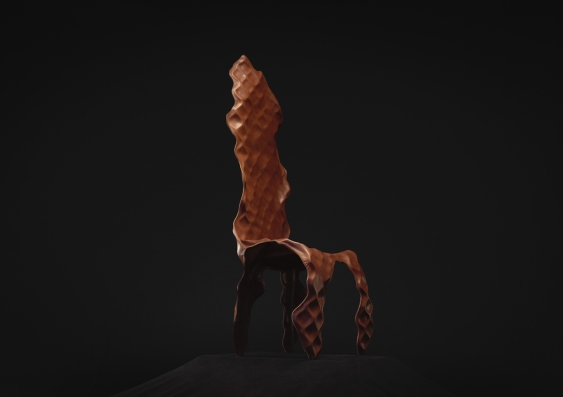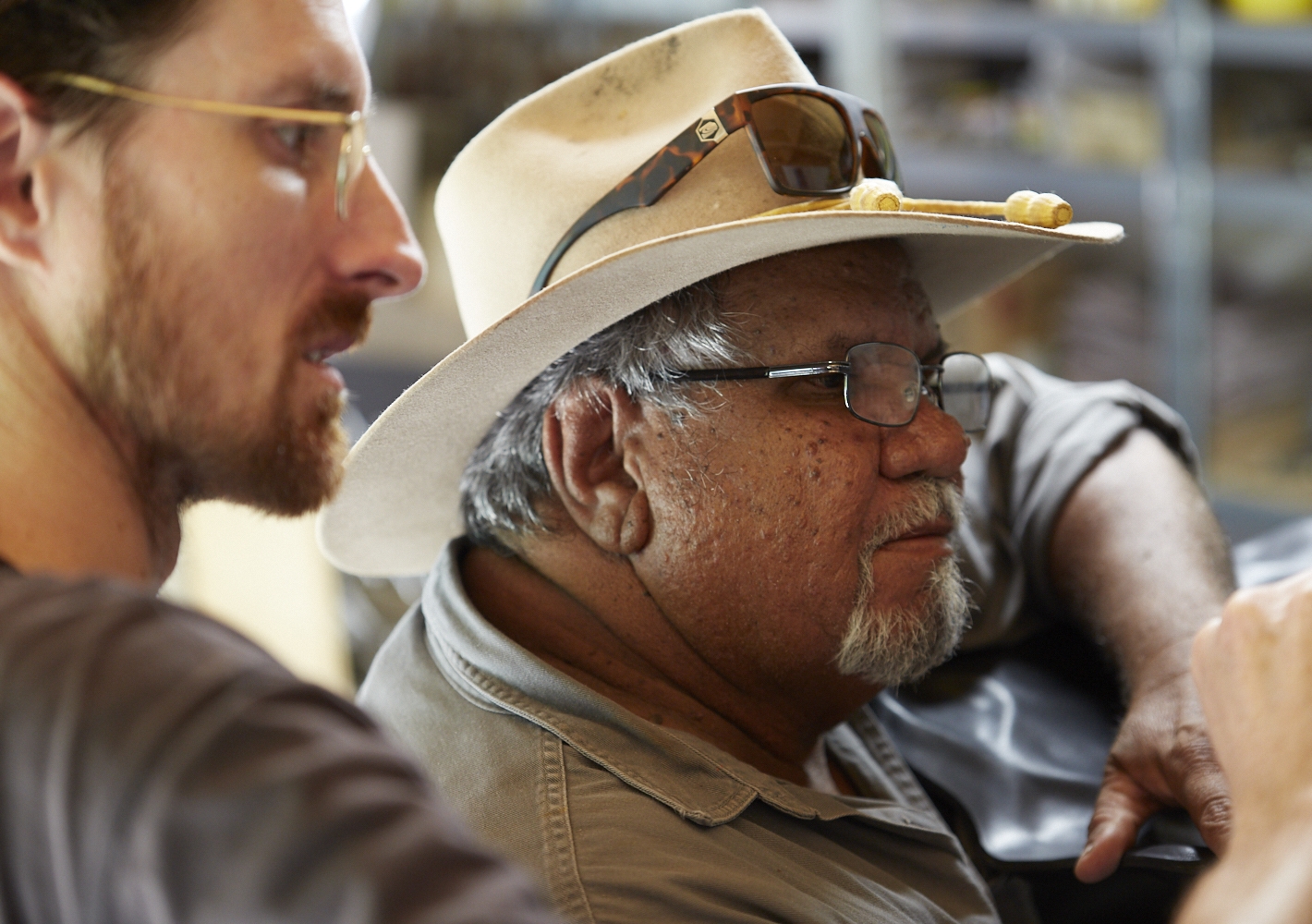Ngumu Jangka Warniti high back chair selected for the National Gallery Victoria’s permanent collection
Unorthodox methods and aesthetics are celebrated in the NGV’s latest acquisition.
Unorthodox methods and aesthetics are celebrated in the NGV’s latest acquisition.

The first artist proof of the Ngumu Jangka Warniti high back chair, a collaboration between designer Trent Jansen and Nyikina man Johnny Nargoodah for Gallery Sally Dan Cuthbert, has been acquired by the National Gallery of Victoria (NGV).
The high back chair is part of their latest shared body of work Partu (2020), which is the Walmajarri word for skin. Ngumu Jangka Warnti is the Walmajarri phrase for ‘all made from rubbish’.
“The design of this collection began with a trip to the local scrap metal yard, in a vague search for anything interesting,” says Dr Jansen, a designer at the School of Art & Design. “We salvaged a selection of discarded aluminium mesh and used this found metal as the starting point for experimentation.”
Dr Jansen and Mr Nargoodah designed each piece as they made it, starting with a mesh substrate cut vaguely in the shape of a chair, and together beating the material with hammers, concrete blocks and tree stumps until it took on a form that they both liked.
This beaten geometry was then softened by laminating New Zealand saddle leather to skin the mesh, masking its geometry and softening its idiosyncratic undulations.
Ewan Mceoin, Simone Leamon and Myf Doughty of NGV selected the work to join the gallery’s permanent collection.
This ethical cross-cultural collaboration continues Dr Jansen’s focus on what he calls design anthropology. The inspiration for his work frequently comes from research and a wider curiosity with “untold stories”, he says.
“A focus of my work for some time has been the embodiment of Australian national identity in designed artefacts, but what is Australian identity without Indigenous Australian cultures? I could not attempt to produce work that is a true representation of Australian-ness without acknowledging the significant contribution of Indigenous Australians to our experience of Australian nationhood.”
Dr Jansen and Mr Nargoodah have been collaborating in the design and crafting of collectable furniture since they met in Mr Nargoodah’s hometown of Fitzroy Crossing in 2016. Their artistic partnership produces unorthodox outcomes as a result of their divergent sensibilities and skills in working animal skins.
Mr Nargoodah has spent much of his life working with leather as a saddler on remote cattle stations, and Dr Jansen is an avant-garde object designer from Thirroul in New South Wales, who experiments with leather and animal pelts in his collectable design work.

For Dr Jansen, the collaboration explores whether co-creators from diverse cultures can produce an artefact that reflects the cultural narrative of both cultures. Photo: Romello Pereira
Both designers approached the work through a different lens. For Dr Jansen, it is an experiment in creating hybrid material culture.
“Material culture theory says the artefacts we create embody the values, ideas, attitudes and assumptions of the culture of the creator. But what if an artefact is created collaboratively by people from diverse cultures?” he says.
“I can’t speak for Johnny, but I collaborate with him because I enjoy his company and I enjoy working with him. We come from very different backgrounds, possessing different ideas and skills, and these contrasts are apparent when we work together – Johnny might teach me about a particular method for manipulating leather or the nostalgic smell of leather and the way it evokes memories of a Kimberley cattle station saddle room.
“I might teach Johnny about the use of computer-aided design in our process, or the relationships I see between our work and other designers developing related projects. It is this complex and ever-evolving cultural exchange that informs our final outcomes, and as such these objects are a metaphor for our relationship; they tell the story of our endeavours to bridge a cultural divide, and I hope that they can encourage others to do the same.”
For Mr Nargoodah, the work’s significance is multi-faceted, from the making to recycling, history, and its immersive sensory experience.
“We use rubbish, recycled frames, we make chairs and cabinets, and use the leather to make it look good, to make it furniture that is usable and looks nice. It is important to reuse old rubbish we find, and the leather makes it special,” he says.
“The leather gives it a reference to the history of Fitzroy Crossing and station life. Saddlers used to come and repair saddles using leather, making twisted rope out of cowhide. This is what I think about when we are using the leather …
“The smell of that leather is so good. It brings back memories, triggers those old memories of walking around the saddle room in Noonkanbah shed. There is a sensory response, that’s important,” he says.
The collection was developed in Thirroul on the New South Wales Coal Coast over an 18-month period. The emphasis was on developing new methods for collaboration to shape their incongruent knowledge and skills in designing and making into co-authored outcomes.
This involved a sketching exchange, a back-and-forth process of sketch iteration, allowing an idea to evolve with equal input from both creators, as well as designing by making, a method of working with materials at full scale, to design an object as it is being made.
“In this approach, the prototype is the sketch and we both work together to carve, construct and/or manipulate material, giving the object three-dimensional form as we design and make simultaneously,” Dr Jansen says.
“It is a huge honour for the first artist proof to be selected to join the prestigious permanent collection of this great public institution,” Dr Jansen says. “It is recognition of the validity of this kind of experimentation.”
“I reckon it’s great because the work will always be safe there, long after we’re gone it’ll still be there with our names on it. I’m proud of it,” says Mr Nargoodah.
The Ngumu Jangka Warniti high back chair will join Jangarra, a piece from their first collaboration, which is also part of the gallery’s permanent collection. Created with fellow Mangkaja artist Rita Minga, the Jangarra is an armchair interpretation of a local mythical creature, fashioned from Jartalu wood, gum branches and human hair.
Partu is assisted by the Australian Government through the Australian Council for the Arts, its arts funding and advisory body, and supported by the School of Art & Design.
Trent Jansen and Johnny Nargoodah are represented by Gallery Sally Dan Cuthbert. Johnny Nargoodah is represented by Mangkaja Arts in Fitzroy Crossing in Western Australia.
Trent Jansen and Johnny Nargoodah, Ngumu Jangka Warniti (All made from rubbish) high back chair, 2020 will be presented in NGV's forthcoming exhibition History in the Making from 19 June to 24 October.